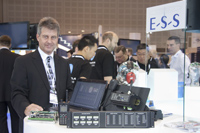|
E-S-S’s latest product is a compact wireless wide-area telemetry (WWAT) module range built into standard DIN rail housings. “We’ve taken very good care of making simplicity for maintainability”, explains Johan Hoolsema. “All the program data is contained in an SD card – so if you have to replace this for whatever odd reason – it might be storm-fallen water – you just take the SD card out and put the new one back in. You don’t have to reprogram the unit. “I’m based in South Africa”, he adds, “and we don’t always have technical staff to be able to replace these units, so the thought process from an engineering point of view is to make it as simple as possible for people to maintain it.” The modules support a wide range of interfaces used in telemetry, telecontrol and Scada systems, with data and LAN ports and RS-232 or RS-485 to support various bus protocols. “We prefer the OPC (online processing control), because that is a world standard. Any modern Scada system in the world will work in OPC. My demonstration here is with an OPC Scada system. That system, as you see, is also being used by the police network in South Africa.” A special feature of the units is an array of tiny indicator LEDs which can be configured to indicate normal or abnormal voltage levels, etc. By glancing at these, the technician can perform a quick diagnostic check without having to connect a test instrument or even remove the cover. The LEDs can be labelled as required. Supporting software for the modules is available in the form of a small application to run on Sepura TETRA radios. “I have got alarms coming in, so this particular alarm would go to a Sepura radio, and you can hear it beeping”, says Mr Hoolsema, demonstrating an industrial plant application. “It will only stop beeping when the operator acknowledges it. So he cannot say ‘I didn’t get the message!’ The operator needs to either reject or acknowledge on the terminal. So in this case, if he then accepts it, that information goes back into the database and a log is kept that the operator has acknowledged this.” Taking into account feedback received at the show, E-S-S plans to enhance this feature so that a PIN code maybe required, as confirmation that the right person has acknowledged the message. And a further step will be to integrate GPS positioning data from the TETRA radio, so that the control room system can verify automatically that the technician has travelled to the required location. (中国集群通信网 | 责任编辑:陈晓亮) |

 Helping to meet an emerging demand for machine communications in
Helping to meet an emerging demand for machine communications in